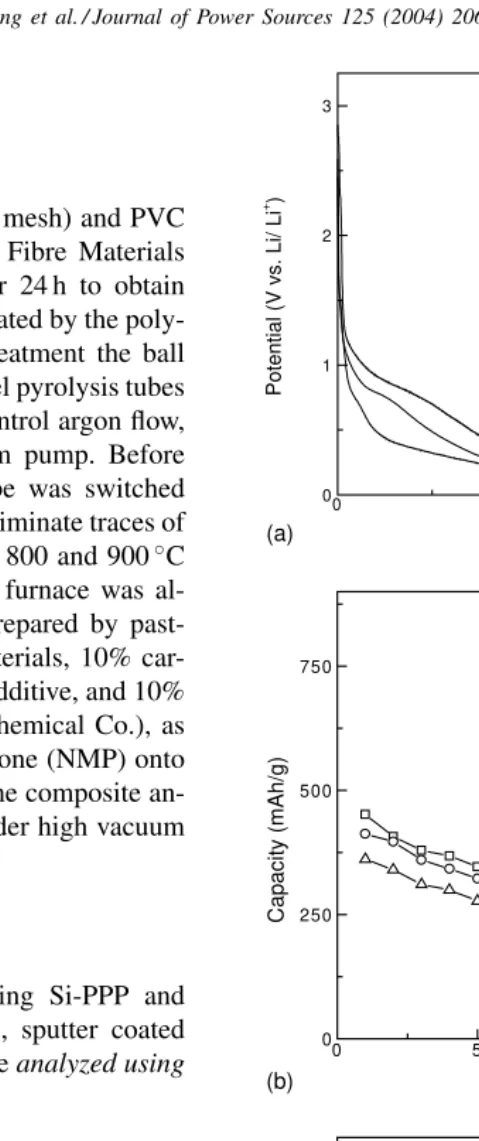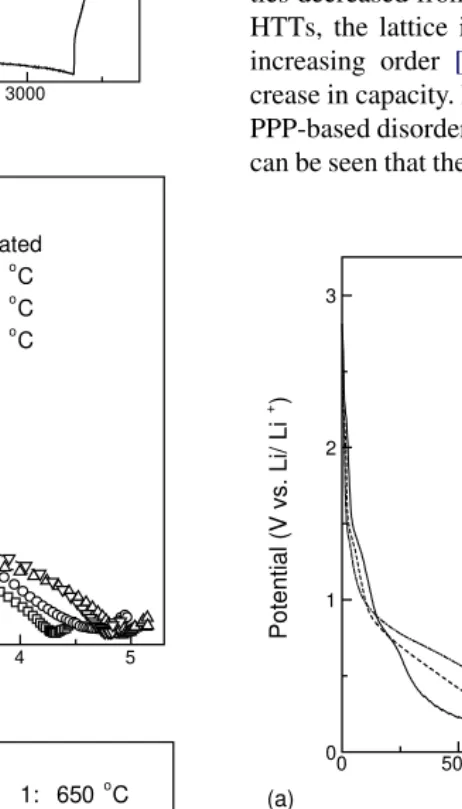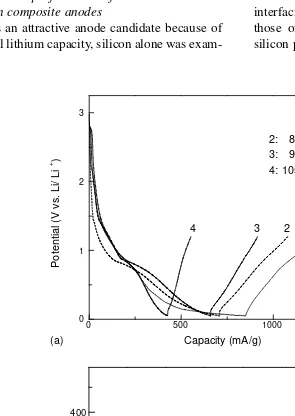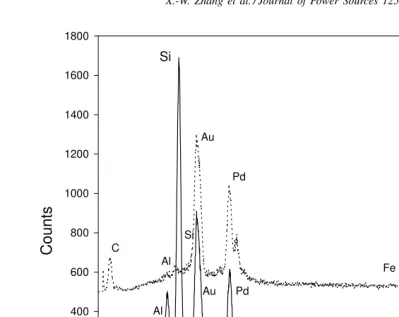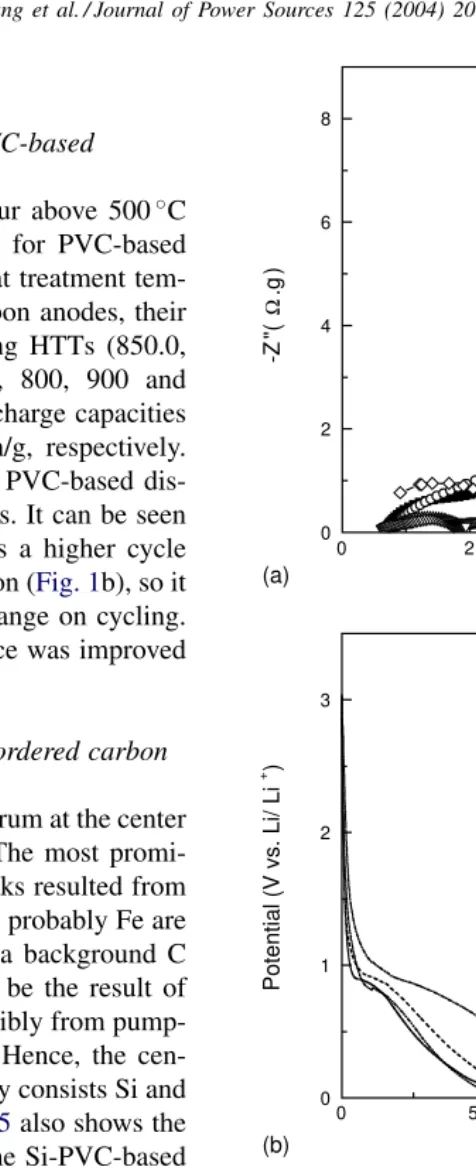Electrochemical performance of lithium ion battery, nano-silicon-based,
disordered carbon composite anodes with different microstructures
Xiang-Wu Zhang
a, Prashanth K. Patil
b, Chunsheng Wang
c,∗,
A. John Appleby
a, Frank. E. Little
d, David L. Cocke
baCenter for Electrochemical Systems and Hydrogen Research, Texas Engineering Experiment Station, Texas A&M University, College Station, TX 77843-3402, USA
bDepartment of Chemistry and Chemical Engineering, Lamar University, PO Box 10022, Beaumont, TX 77710, USA cCenter for Manufacturing Research, Tennessee Technological University, Box 5077, Cookeville, TN 38505, USA dCenter for Space Power, Texas Engineering Experiment Station, Texas A&M University, College Station, TX 77843-3402, USA
Received 21 July 2003; accepted 31 July 2003
Abstract
Nano-silicon-based disordered carbon composites prepared by mechanical milling and pyrolysis have been examined as anodes of a lithium ion cell. Electrochemical measurements show that the charge–discharge capacity of disordered carbon composites incorporating both silicon-polyparaphenylene (Si-PPP) and silicon-polyvinyl chloride (Si-PVC) with differing silicon contents, decreases with increasing pyrolysis temperature. Si-PVC-based materials have a better cycle life than those based on Si-PPP at the same silicon content.
© 2003 Elsevier B.V. All rights reserved.
Keywords:Lithium ion battery; Silicon; Polyparaphenylene (PPP); Polyvinyl chloride (PVC); Disordered carbon; EIS
1. Introduction
Lithium ion secondary batteries are now being used in wide applications. To improve performance, new anode ma-terials and determination of anode reaction mechanisms are required [1,2]. Carbon intercalation anode materials have been most frequently studied. A wide range of carbonaceous materials intercalates lithium atoms and serves as lithium insertion anodes in lithium ion battery electrodes. Carbon anode materials have the advantages of long cycle life and low cost. However, they have the disadvantages of low re-versible capacity and irrere-versible capacity loss (ICL)[3].
Lithium alloys are also attractive anode candidates be-cause they can incorporate large amounts of lithium. For example, Li4.4Si has a theoretical capacity of 4200 mA h/g.
The major problem associated with the use of silicon/lithium appears to be mechanical failure brought about by the repeated large volume changes associated with the alloy-ing/dealloying[4,5]. Metallic and intermetallic anodic host materials other than layer materials such as graphite are
re-∗Corresponding author. Tel.:+1-931-372-3678; fax:+1-931-372-6345.
E-mail address:[email protected] (C. Wang).
ported to disintegrate after a few lithium insertion/extraction cycles[5,6]unless they are in fine powder form.
Previous work has shown that the use of simple blends or mechanically milled silicon carbon composite nanosize pow-ers did not suppress capacity fade on cycling[7,8]. Silicon covered with carbon by a thermal vapor deposition (TVD) method showed high reversible capacity and improved cycle stability under controlled lithium insertion conditions [9]. The optimal Si–C composite structure may be highly dis-persed silicon in a carbon matrix[10,11].
In the present study, the goal was to develop a new nano-composite anode by combining the advantageous properties of carbon (long cycle life) and silicon (high Li storage capacity) to improve both the capacity and reten-tion of electrode structure by coating silicon particles with disordered carbon. This has been achieved using methods different from those in previous work, namely by using me-chanical milling of silicon-polyparaphenylene (Si-PPP) and silicon-polyvinylchloride (Si-PVC) followed by in situ py-rolysis at a wide range of temperatures. The products were characterized by EDAX and their electrochemical perfor-mance was determined by EIS. PPP and PVC-based disor-dered carbons were also prepared by pyrolysis to compare their performance with the silicon-containing composites.
2. Experimental procedure
2.1. Electrode preparation
Weighed quantities of Si powder (∼325 mesh) and PVC (Aldrich Chemical Co.) or PPP (Qingdao Fibre Materials Co., China) were mechanically milled for 24 h to obtain Si–polymer composites with Si particles coated by the poly-mer. To avoid Si oxidation during heat treatment the ball milled mixtures were sealed in stainless steel pyrolysis tubes with two valves. One valve was used to control argon flow, and the other was connected to a vacuum pump. Before heat treatment, the atmosphere in the tube was switched three times between argon and vacuum to eliminate traces of air. The mixtures were then heated at 650, 800 and 900◦C
for 2.0 h under argon atmosphere and the furnace was al-lowed to cool. Composite anodes were prepared by past-ing a slurry containpast-ing 80 wt.% active materials, 10% car-bon black as an electronically conducting additive, and 10% polyvinylidene fluoride (PVDF, Aldrich Chemical Co.), as a binder, suspended in 1-methyl-2-pyrrolidone (NMP) onto both sides of a copper gauze. Before use, the composite an-odes were pressed and rigorously dried under high vacuum at 100◦C.
2.2. Materials characterization
The microstructures of silicon containing Si-PPP and Si-PVC-based disordered carbon particles, sputter coated with Au–Pd alloy to suppress charging wereanalyzed using
EDAX.
2.3. Electrochemical characterization
Electrochemical charge–discharge behavior was exam-ined in a three-electrode PTFE cell containing excess 1.0 M LiPF6 solution in a 3:5:4:1 by volume ethylene
car-bonate (EC)–diethyl carcar-bonate (DEC)–dimethyl carcar-bonate (DMC)–ethyl methyl carbonate (EMC) mixture (Em In-dustries, Inc.). Two lithium foils were used as counter and reference electrodes. All potentials given are vs. Li/Li+ in
this electrolyte. Cells were assembled in an argon-filled glove box. Charge (lithium insertion) and discharge (lithium extraction) were conducted using an Arbin (College Sta-tion, TX) automatic battery cycler at current densities of 5.0 mA g−1to cut-off potentials of 0.05 and 1.2 V.
Electrochemical impedance spectroscopy (EIS) was per-formed using a Solartron FRA 1250 frequency response analyzer and a Solartron model 1286 electrochemical in-terface. Before each measurement, the electrodes were first charged galvanostatically at 10 mA g−1 to 0.05 V,
then left on open-circuit for 5.0 h to allow their potential to stabilize. EIS measurements were carried out using a 10.0 mV AC voltage signal in the 65 kHz–10 mHz fre-quency range in automatic sweep mode from high to low frequency.
0 500 1000 1500
0 1 2 3
3 2 1
Potential (V vs. Li/ Li
+ )
0 1 2 3 4 5
0 500 1000 1500 2000
0
0 1000 2000 3000
0
Fig. 2. Electrochemical performance of Si and 50 wt.% Si-PPP-based dis-ordered carbon anodes with differing HTTs: (a) charge–discharge curve of Si anode; (b) electrochemical impedance spectra of Si-PPP-based dis-ordered carbon anodes; and (c) charge–discharge curves of Si-PPP-based disordered carbon anodes.
3. Results and discussion
3.1. Si-PPP-based disordered carbon composite anodes
3.1.1. Electrochemical performance of PPP-based disordered carbon
Fig. 1a shows potential profiles for PPP-based disor-dered carbon composite anodes with differing heat treat-ment temperatures (HTTs). With increasing HTTs from 650 to 900◦C, the charge capacities of disordered carbon
decreased from 970.7 to 716 mA h/g, and discharge capaci-ties decreased from 451.3 to 361.0 mA h/g. With increasing HTTs, the lattice in PPP-based disordered carbon showed increasing order [12–14], explaining the progressive de-crease in capacity.Fig. 1b shows the cycling performance of PPP-based disordered carbon anodes with differing HTTs. It can be seen that the PPP-based disordered carbon has a good
0 500 1000 1500 2000
0 1 2 3
32 1
Potential (V vs. Li/ Li
+ )
cycle lifetime, because its high mechanical strength accom-modates the volume change of silicon on cycling. Fig. 1c shows electrochemical impedance spectra of PPP-based disordered carbon anodes with differing HTTs. For com-parison, the impedance spectrum of PPP is also plotted in
Fig. 1c. Typical impedance spectra all show one depressed semicircle for the interfacial impedance, which is usually taken to be for interfacial Li charge transfer associated with the formation of the passive surface electrode interface (SEI) film. From Fig. 1c, it can be seen that pyrolysis of PPP did not greatly change the interfacial impedance.
3.1.2. Electrochemical performance of Si-PPP-based disordered carbon composite anodes
Since silicon is an attractive anode candidate because of its high theoretical lithium capacity, silicon alone was
exam-0 500 1000 1500
0 1 2 3
4 3 2 1
Potential (V vs. Li/ Li
+ )
Capacity (mA/g)
2: 800oC
3: 900oC
4: 1050oC
0 5 10 15 20
0 100 200 300 400
Capacity (mAh/g)
Cycle Number
650 oC 800 oC 900 oC 1050 oC
(a)
(b)
Fig. 4. Electrochemical performance of PVC-based disordered carbon composite anodes with differing HTTs: (a) charge–discharge curves; and (b) cycling performance measured as discharge capacity.
ined as an anode.Fig. 2a shows the potential profile of the silicon anode. During charging, a potential plateau appeared at about 0.2 V vs. Li/Li+, and the charge capacity was about
Energy (KeV)
0 2 4 6 8 10
Counts
0 200 400 600 800 1000 1200 1400 1600 1800
Si
Al
Au Pd
C
Fe Au
C
Au
Pd
Fe Au
Si
Al
Fig. 5. EDAX spectrum at the center (solid line) and edge (dotted line) of a 33% Si-PVC-based disordered carbon particle (HTT=800◦C).
Fig. 2c shows the potential profile of 50 wt.% Si-PPP-based disordered carbon composite anodes. Charge–discharge testing showed that cycling performance was still unsatis-factory, since only about 50% of the discharge capacity in the first cycle remained in the second. A possible reason may be the high silicon to carbon ratio, giving insufficient mechanical strength to accommodate the large silicon vol-ume change. The Si content was therefore decreased to
0.6 1.0 1.4 1.8 2. 2 2.6 3.0
0.0 0.4 0.8
-Z
"
(
Ω
.g
)
Z' (Ω.g)
650oC
800oC
900oC
1050oC
Fig. 6. Electrochemical impedance spectra of PVC-based disordered carbon anodes with different HTTs.
3.2. Si-PVC-based disordered carbon
3.2.1. Electrochemical performance of PVC-based disordered carbon
Carbonization of PVC is known to occur above 500◦
C
[15]. Fig. 4a shows the potential profiles for PVC-based disordered carbon anodes with varying heat treatment tem-peratures (HTTs). As with PPP-based carbon anodes, their charge capacities decreased with increasing HTTs (850.0, 708.7, 660.2 and 426.72 mA h/g at 650, 800, 900 and 1050◦C, respectively). Similarly, their discharge capacities
were 386.0, 369.1, 253.5 and 126.2 mA h/g, respectively.
Fig. 4b shows the cycling performance of PVC-based dis-ordered carbon anodes with differing HTTs. It can be seen that the PVC-based disordered carbon has a higher cycle life than that of PPP-based disordered carbon (Fig. 1b), so it can better accommodate the Si volume change on cycling.
Fig. 4b also shows that cycling performance was improved with increasing HTT.
3.2.2. Structure of 33% Si-PVC-based disordered carbon composite anodes
Fig. 5shows the EDAX (solid line) spectrum at the center of a 33% Si-PVC-based carbon particle. The most promi-nent peak is that of Si. The Au and Pd peaks resulted from sputtering before measurement, and Al and probably Fe are from the polishing powder. There is also a background C line (smaller than that of Al), which may be the result of carbon from the pyrolysis of PVC and possibly from pump-ing oils, and other organic contaminants. Hence, the cen-ter of Si-PVC-based carbon particles mainly consists Si and possibly a small amount of coated C.Fig. 5also shows the EDAX (dotted line) at the edge of the same Si-PVC-based carbon particle. The Si peak has disappeared, whereas the C peak has increased to become larger than the Al peak, indi-cating that the particle edge consists of C without Si. Taken together, both sets of data showed that the Si particles were probably coated with a disordered carbon layer.
3.2.3. Electrochemical performance of 33 and 25 wt.% Si-PVC-based disordered carbon composite anodes
PVC polymer is known to carbonize via a low-viscosity liquid phase, which permits the formation of uniform car-bonaceous coatings [16].Fig. 6shows the electrochemical impedance spectra of PVC-based disordered carbon anodes with differing HTTs. It can be seen that the interfacial impedances of PVC-based carbon are not greatly affected by the HTTs, which is similar to that of PPP-based carbon (Fig. 1c).Fig. 7a shows the electrochemical impedance spec-tra of 33 wt.% Si-PVC-based disordered carbon composite anodes with differing HTTs. For comparison, the impedance spectrum of Si was also plotted. It can be seen that, when the HTTs are 800 or 900◦C, the interfacial impedances of
the anodes are similar to those of the PVC-based carbon anodes (Fig. 6). This indicates that the Si particles have probably been coated by a carbon layer. However, when the
0 2 4 6 8
0 500 1000 1500 2000
0 1 2 3
4 132
Potential (V vs. Li/ Li
+ )
0 2 4 6 8
0 500 1000 1500 2000
0 1 2 3
1 4 3 2
Potential (V vs. Li/ Li
+ )
Fig. 8. Electrochemical performance of 25 wt.% Si-PVC-based disordered carbon anodes with different HTTs: (a) electrochemical impedance spectra; (b) charge–discharge curves; and (c) cycling performance measured as discharge capacity.
HTTs are 650 or 1050◦C, the Si particles are only partially
coated. This is indicated by the interfacial impedances of the anodes being larger than those of the carbon anodes (Fig. 6).
Fig. 7b shows the potential profiles for 33 wt.% Si-PVC-based disordered carbon composite anodes with differing HTTs. When the HTTs are 650 or 1050◦
C, the incomplete carbon coatings cannot accommodate the large Si particle volume change, even during the first cycle. As a result, the capacities of composite anodes heat-treated at these temperatures are relatively low. When the HTTs are 800 and 900◦C, the integrated carbon layers are sufficiently
strong to accommodate the Si volume change, at least in the first cycle. Hence, their capacities are high. The charge and discharge capacities of a composite anode heat-treated at 800◦C were 1231.4 and 548.8 mA h/g, respectively,
while those of anodes heat-treated at 900◦C were 1150.6
and 468.3 mA h/g, respectively. Since accommodation of the Si particle volume change largely determines the cycle performance of each type of anode, cycling performance is strongly influenced by the HTTs. Fig. 7c shows the cycle performance of 33 wt.% Si-PVC-based disordered carbon anodes with differing HTTs. When the Si particles are incompletely coated (at HTT 650 and 1050◦C), cycle
performance is poor. However, cycle performance is good when the Si particles are coated (at HTT 800 and 900◦C).
The integrated carbon layer therefore plays an important role in the electrochemical performance of Si-PVC-based disordered carbon composite anodes. Hence, the elec-trochemical performance of 25 wt.% Si-PVC-based an-odes with a thicker carbon layer was studied. Fig. 8a shows the electrochemical impedance spectra of 25 wt.% Si-PVC-based anodes with different HTTs. It can be seen that the interface impedances for all the Si-PVC-based an-odes are similar to those of PVC-based pure carbon anan-odes (Fig. 6), which indicates that the Si particles are likely coated by carbon. Fig. 8b shows the potential profiles for these anodes as a function of the HTTs. Both their charge and discharge capacities are higher than the corresponding capacities of 33 wt.% Si-PVC-based anodes. Although the theoretical capacity of silicon is almost 10 times that of PVC-based carbon, decreasing silicon content still results in an increase in capacity. Fig. 8c shows the greatly im-proved cycle performance of 25 wt.% Si-PVC-based anodes with differing HTTs. Hence the improved performance of silicon with PVC-based disordered carbon over that with PPP-based carbon is clearly evident from the capacities, potential profiles, and impedance spectra. The uniformity of the carbon layer plays an important role in improving the capacity and cycle lifetime.
4. Conclusions
theoretical capacity but low cycle life due to large volume changes occurring during lithium insertion, is improved by pyrolysis of PPP and PVC admixtures. The strong carbon layer resulting from pyrolysis of PPP and PVC of me-chanically milled Si-PPP or PVC composites appears to effectively accommodate the Si volume change. Therefore, Si-PPP- or PVC-based disordered carbon composites hold the promise of improving capacity, cycle life and mechan-ical strength.
It has been found that uniformity of the carbon layer plays an important role in improving the capacity and cycle lifetime. Coatings formed by PVC-based carbon appear to be more uniform than those by PPP-based carbon, offer-ing better accommodation of the silicon volume change, and increasing capacity and cycle life. A further improve-ment in anode performance is expected by optimizing the silicon/carbon ratio required for complete coating by dis-ordered carbon. This is the subject of current and future investigations.
Acknowledgements
We gratefully acknowledge NASA-Glenn Research Cen-ter (Grant No. NAG3-2617) and the Welch Foundation Grant number V-1103 for supporting this work.
References
[1] S. Megahed, B. Scrosati, J. Power Sources 51 (1994) 79. [2] P. Zhou, P. Papanek, C. Bindra, et al., J. Power Sources 68 (1997)
296.
[3] K. Kinoshita, K. Zaghib, J. Power Sources 110 (2002) 416. [4] R.A. Huggins, in: J.O. Besenhard (Ed.), Handbook of Battery
Ma-terials, Wiely/VCH, Weinheim, 1999, p. 359.
[5] J.O. Besenhard, J. Yang, M. Winter, J. Power Sources 68 (1997) 87.
[6] L.Y. Beaulieu, D. Larcher, R.A. Dunlap, J.R. Dahn, J. Electrochem. Soc. 147 (2000) 3206.
[7] H. Li, X. Huang, L. Chen, Z. Wu, Y. Liang, Electrochem. Solid State Lett. 2 (1999) 547.
[8] C.S. Wang, G.T. Wu, X.B. Xhang, Z.F. Qi, W.Z. Li, J. Electrochem. Soc. 145 (1998) 2751.
[9] M. Yoshio, H. Wang, K. Fukuda, T. Umeno, N. Dimov, Z. Ogumi, J. Electrochem. Soc. 149 (2002) A1598.
[10] N. Kurita, M. Endo, Carbon 40 (2002) 253.
[11] W. Xiang, A.M. Wilson, K. Eguchi, G. Zank, J.R. Dahn, Solid State Ionics 74 (1997) 2410.
[12] J.R. Dahn, A.K. Sleigh, H. Shi, J.N. Reimers, Q. Zhong, B.M. Way, Electrochim. Acta 38 (1993) 1179.
[13] N. Kambe, M.S. Dresselhaus, G. Dresselhaus, S. Basu, A.R. McGhie, J.E. Fischer, Mater. Sci. Eng. 40 (1979) 1.
[14] K. Tatsumi, A. Mabuchi, N. Iwashita, H. Sakaebe, H. Shioyama, H. Fujimoto, S. Higuchi, J. Electrochem. Soc. 142 (1995) 716. [15] D. Dollimore, G.R. Heal, Carbon 5 (1967) 65.
